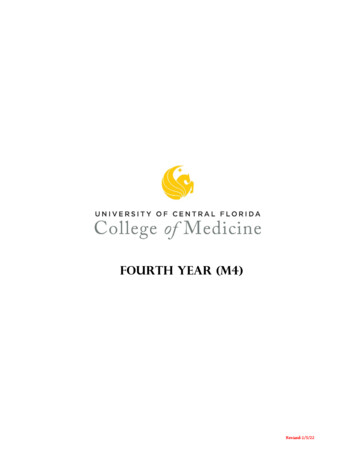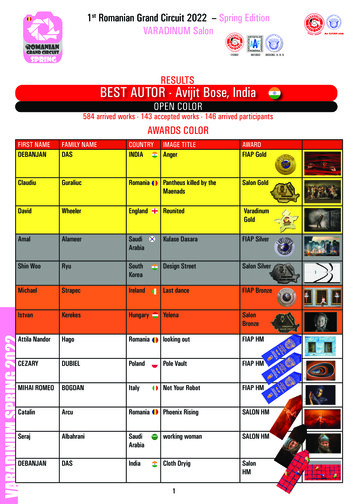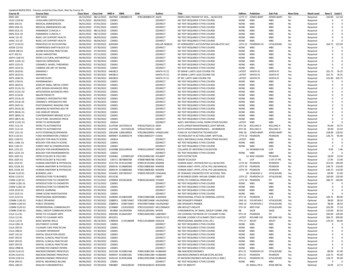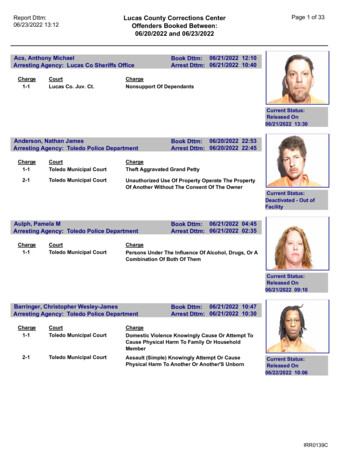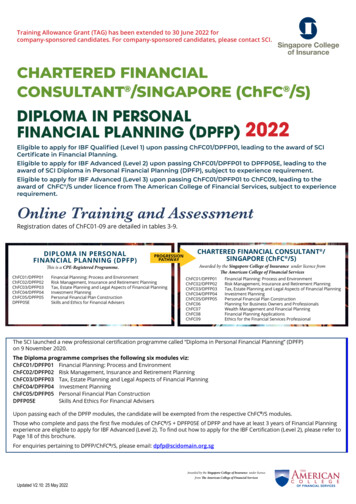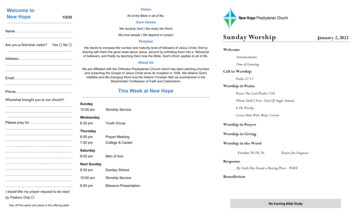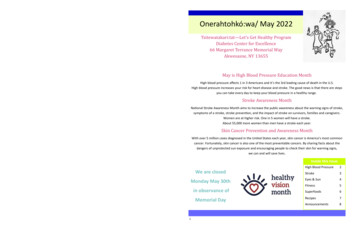
Transcription
AnnouncementsOnerahtohkó:wa/ May 2022If you are interested in utilizing the Medical Fitness Program(formerly called Move for Health)please call Heather Garrow at: (518) 358-9667Tsitewatakari:tat—Let’s Get Healthy ProgramDiabetes Center for Excellence66 Margaret Terrance Memorial WayAkwesasne, NY 13655Public Fitness is back!The class will be held Monday - Friday, 12:00 - 1:00 pm and is open to thecommunity. The class will be an “open gym” format. Please use the parking lotand entrance to the fitness room located at the back of the Diabetes Center.May is High Blood Pressure Education MonthCOVID-19 safety guidelines are in place; please wear your mask at all times, try tostay 6 feet apart, and if you don’t feel well, please wait until your symptomssubside.High blood pressure affects 1 in 3 Americans and it’s the 3rd leading cause of death in the U.S.High blood pressure increases your risk for heart disease and stroke. The good news is that there are stepsyou can take every day to keep your blood pressure in a healthy range.Stroke Awareness MonthOnly 15 participants are allowed during this time. Should we reach 15, the doorwill be locked. The lockers are open for use during this time, but showers are not.National Stroke Awareness Month aims to increase the public awareness about the warning signs of stroke,symptoms of a stroke, stroke prevention, and the impact of stroke on survivors, families and caregivers.Women are at higher risk. One in 5 women will have a stroke.About 55,000 more women than men have a stroke each year.Remember to bring clean, dry shoes.Skin Cancer Prevention and Awareness MonthNiá:wen for your patienceWith over 5 million cases diagnosed in the United States each year, skin cancer is America’s most commoncancer. Fortunately, skin cancer is also one of the most preventable cancers. By sharing facts about thedangers of unprotected sun exposure and encouraging people to check their skin for warning signs,we can and will save lives.Inside this IssueWe are closedMonday May 30thin observance ofWorkingTogether Todayto Build aMemorial DayBetter Tomorrow81High Blood Pressure2Stroke3Eyes & Sun4Fitness5Superfoods6Recipes7Announcements8
RecipesHigh Blood PressureEvery time your heart beats, it pumps blood through vessels, called arteries, to the rest of your body. Yourblood pressure is how hard your blood pushes against the walls of the arteries. If your blood flows at higherthan normal pressures, you may have high blood pressure, also known as hypertension. High blood pressureis a major risk factor for heart disease, which is the leading cause of death in the United States. Millions ofAmericans have high blood pressure, but many people who have it don’t know it. That’s why it is importantto have your blood pressure checked at least once a year.High blood pressure is a “silent killer.” It doesn’t usually cause symptoms, but it can damage your body overtime.If your blood pressure stays higher than 130/80 mm Hg for a period of time, it can cause serious healthproblems such as: Heart disease, Stroke, Kidney disease, and DementiaThe only way to know whether you have high blood pressure is to have your blood pressure measuredIf you find out you have high blood pressure, a health care professional can tell you how to prevent seriouscomplications, including disability and premature death.What steps can you take to lower your blood pressure? Set targets: work with your doctor to set blood pressure numbers that are healthy for you. Take control: Make lifestyle changes such as eating healthy, staying active, and watching your weight.If you smoke, quitting can help prevent heart disease and other complications of high blood pressure. Work together: Studies show that if you engage in heart healthy activities with people at home, at work,in your community, or online, you have a better chance of staying motivated.Making lifestyle changes now can help keep your blood pressure in a healthy range— whether you have highblood pressure or you’re trying to prevent it. You don’t have to make big changes all at once. Small steps canget you where you want to go. Here are some ideas to start. If you have elevated blood pressure and yourdoctor prescribes medications, make sure to take them as directed.Eat Healthy Foods: A diet low in sodiumand saturated fat—like the DASH eatingplan—can lower your blood pressure aseffectively as medicines.Add one fruit or vegetable to every meal.If you get fast food, ask for a salad instead of fries.Give Meatless Monday a try.Commit to one salt-free day a week. Use herbs for flavor instead.Move More: Get at least 2½ hours ofphysical activity a week to help lowerand control blood pressure. That’s just30 minutes a day, 5 days a week.Invite a friend for regular walks or an exercise class.Take the stairs.Take a break to play outside with your kids.March in place during commercial breaks while watchingtelevision with your family.Manage Stress: Stress can contribute tohigh blood pressure and other heartrisks. If it goes on for a long time, it canmake your body store more fat.2Practice mindful meditation for 10 minutes a day.Try deep breathing techniques.Read a book.Take a relaxing bath.Honey Soy-Glazed SalmonIngredients:3/4 lbs. wild-caught salmon fillet1 TBSP soy sauce (reduced-sodium)1 TBSP honeyOlive oil cooking spraySalt and freshly ground pepperDirections:Rinse salmon and pat dry with a paper towel.Heat a nonstick skillet over medium-high heat, and spray with olive oil spray.Brown salmon 2 minutes; turn and brown 1 minute.Season the cooked sides with salt and pepper.Reduce heat to low, cover, and let cook 7-8 minutes.Remove from heat. Mix honey and soy sauce together.Pour over the salmon, cover, and let sit 1 minute. Serve.Nutrition FactsCalories: 303Total Fat: 12gCholesterol: 95mgCarbohydrates: 12gProtein: 39gSodium: 370mgGreek Quinoa SaladIngredients:1 C quinoa2 C low sodium chicken broth1 large cucumber (peeled, seeded and diced)10.5 oz. grape tomatoes (cut in half)1/4 C red onion (finely diced)1/4 C fresh parsley (chopped)1/2 C feta cheese (reduced-fat, crumbled)1/4 C red wine vinegar2 TBSP olive oil1/2 TBSP Dijon Mustard1/2 packet SplendaNutrition FactsCalories: 115Total Fat: 5gCholesterol: 5mgCarbohydrates: 14gProtein: 5gSodium: 135mgDirections:Cook quinoa according to package directions with chicken broth. Let cool completely.In a large salad bowl, combine cooled quinoa and remaining salad ingredients.In a small bowl, whisk together dressing ingredients. Pour over salad and mix to coat. Serve cold.7
Stroke AwarenessDiabetes SuperfoodsWhat superstar foods are good for diabetes?“Superfood” is a term used by many food and beverage companies as a way to promote a food thought tohave health benefits; however, there is no official definition of the word by the Food and DrugAdministration (FDA). The FDA regulates the health claims allowed on food labels to ensure there is scientificresearch to support the claims. The list of foods below are rich in vitamins, minerals, antioxidants and fiberthat are good for overall health and may also help prevent disease.Stroke is the No. 5 cause of death and a leading cause of disability. A stroke occurs when something blocksblood supply to part of the brain or when a blood vessel in the brain bursts. In either case, parts of the brainbecome damaged or die. A stroke can cause lasting brain damage, long-term disability, or even death. Strokecan happen to anyone, any age at any time and everyone needs to know the warning signs.Stroke: If you think someone may be having a stroke, act F.A.S.T. and perform the following simple test:F - Face: Ask the person to smile. Does one side of the face droop?Beans: Kidney, pinto, navy or black beans are packed with vitamins and minerals such as magnesium andpotassium. They are very high in fiber too.A - Arms: Ask the person to raise both arms. Does one arm drift downward?Beans do contain carbohydrates, but ½ cup also provides as much protein as an ounce of meat without thesaturated fat. To save time you can use canned beans, but be sure to drain and rinse them to get rid of asmuch added salt as possible.T - Time: If you observe any of these signs, call for help immediately. Early treatment is essential.Dark green leafy vegetables: Spinach, collards and kale are dark green leafy vegetables packed with vitaminsand minerals such as vitamins A, C, E and K, iron, calcium and potassium. These powerhouse foods are low incalories and carbohydrates too. Try adding dark leafy vegetables to salads, soups and stews.Citrus fruit: Grapefruits, oranges, lemons and limes or pick your favorites to get part of your daily dose offiber, vitamin C, folate and potassium.Berries: Which are your favorites: blueberries, strawberries or another variety? Regardless, they are allpacked with antioxidants, vitamins and fiber. Berries can be a great option to satisfy your sweet tooth andthey provide an added benefit of vitamin C, vitamin K, manganese, potassium and fiber.Tomatoes: The good news is that no matter how you like your tomatoes, pureed, raw, or in a sauce, you’reeating vital nutrients like vitamin C, vitamin E and potassium.Fish high in omega-3 fatty acids: Omega-3 fats may help to reduce the risk of heart disease andinflammation. Fish high in these healthy fats are sometimes referred to as "fatty fish." Salmon is well knownin this group. Other fish high in omega-3 are herring, sardines, mackerel, trout and albacore tuna. Choosefish that is broiled, baked or grilled to avoid the carbohydrate and extra calories that would be in fish that isbreaded and fried. The American Diabetes Association Standards of Medical Care in Diabetes recommendseating fish (mainly fatty fish) twice per week for people with diabetes.Nuts: An ounce of nuts can go a long way in getting key healthy fats along with helping to manage hunger. Inaddition, they offer magnesium and fiber. Some nuts and seeds, such as walnuts and flax seeds, are a goodsource of omega-3 fatty acids.Whole grains: It’s the whole grain you’re after. The first ingredient on the label should have the word“whole” in it. Whole grains are rich in vitamins and minerals like magnesium, B vitamins, chromium, iron andfolate. They are a great source of fiber too. Some examples of whole grains are whole oats, quinoa, wholegrain barley and farro.Tips for eating on a budget: Some of the items above can be tough on the budget depending on the seasonand where you live. Look for lower cost options such as fruit and vegetables in season or frozen or cannedfish. Foods that are easier on the budget year round are beans and whole grains that you cook from scratch.S - Speech: Ask the person to repeat a simple phrase. Is their speech slurred or strange?Stroke is an EMERGENCY. Call 911 immediately. Early treatment leads to higher survival rates and lowerdisability rates. Calling 911 lets first responders start treatment on someone experiencing stroke symptomsbefore arriving at the hospital.Other Stroke Symptoms - Watch for Sudden: NUMBNESS or weakness of face, arm, or leg, especially on one side of the body CONFUSION, trouble speaking or understanding speech TROUBLE SEEING in one or both eyes TROUBLE WALKING, dizziness, loss of balance or coordination SEVERE HEADACHE with no known causeDiabetes and Stroke Prevention: 80% of strokes are caused by lifestyle; therefore, strokes can be prevented.People who have diabetes are 2 times as likely to have a stroke compared to people who do not havediabetes. People with diabetes also tend to develop heart disease or have a stroke at an earlier age thanpeople without diabetes. Every 2 minutes an American adult with diabetes is hospitalized for stroke.People with diabetes can live long, healthy lives, free from heart disease, stroke, and other health problems.Recognizing the connection between diabetes and stroke is the first step towards lowering stroke risk.Take these steps to prevent stroke: Maintain a heart-healthy diet: Eat at least 14 grams of fiber daily for every 1,000 calories consumed. Maintain a healthy weight: Having a measurement of 35 inches or more for women or 40 inches or morefor men raises the risk of diabetes. Exercise every day: Even a brisk walk, swim, or yard work can improve your health and may reduce yourstroke risk. Be sure to talk to your doctor before starting any exercise program. Don’t smoke or vape: Smoking puts individuals at higher risk for heart disease and stroke Limit alcohol: No more than one drink a day for women, and no more than two drinks a day for men. Learn to manage stress: Find activities you enjoy to wind down each day, even if for 5-10 minutes. Talk to your doctor: Keep your doctor informed about your current health and ask about preventivemeasures.Diabetes Superstar Foods ADA63
Diabetes and Your EyesHaving diabetes increases your risk for eye diseases that can cause vision loss and blindness — includingdiabetic retinopathy. The good news? Getting regular eye exams and taking steps to manage your diabetescan protect your vision.Get a dilated eye exam at least once a year. It’s the best way to catch vision problems early, when they'reeasier to treat.FitnessStaying Safe When Exercising Outdoors for Older Adults in Rural AreasYou’ve made a plan to be more active, and you’re ready to get outside and get started. But before you do,make sure that you can exercise safely in your neighborhood. Here are a few tips that can help you stay safeas you get moving. Take medicines that your doctor prescribes– even when you’re feeling well Eat a variety of healthy foods— including foods that are low in saturated fats, added sugars, and saltThink Ahead About Safety: Carry your ID with emergency contact information and bring a small amount of cash and a cell phonewith you, especially if walking alone. Stay alert by not talking on the phone as you walk and keeping thevolume low on your headphones. Let others know where you’re going and when you plan to be back. Get active. Start slow by taking 5 minute walks and build up from there Stick to well-lit places with other people around. If you smoke, talk to your doctor about ways to quit Ask your doctor what your A1C, blood pressure, and cholesterol numbers are — and what you can do tomanage themBe seen to be safe. Wear light or brightly colored clothing during the day. Wear reflective material onyour clothing and carry a flashlight at night. Put lights on the front and back of your bike. Wear sturdy, appropriate shoes for your activity that give you proper footing.You can also take these steps to manage your diabetes and keep your eyes healthy:Learn more at nei.nih.gov/DiabetesWalk Safely in Rural Areas:Sun ProtectionThe sun sustains life and feels good, but it can be your skin’s worst enemy. While every sunburn can increaseyour risk of skin cancer, it’s not just those big days at the beach that cause trouble. Each time you gooutdoors without sun protection also adds to the damage that can lead to skin cancer (as well as leatheryskin, dark spots and wrinkles).Know Your Sunscreen: Sunscreens come in many formulations and delivery methods, and it can take trial anderror to find the one you like best. Whether it’s a sport spray, an easy-to-use stick or a rich moisturizer withantiaging ingredients, the best sunscreen is the one you will use every day.SPF stands for sun protection factor. The number tells you how long the sun’s UVB rays would take to reddenyour skin when using a particular sunscreen compared with the amount of time without sunscreen. So if youuse an SPF 15 product exactly as directed (applied generously and evenly, and reapplied after two hours orafter sweating or swimming), it would take you 15 times longer to burn than if you weren’t using sunscreen. If possible, walk during daylight hours. Choose routes that are well-used, well-lit, and safe. Choose routes with places to sit in case you want tostop and rest. Stay alert at all times. If you’re listening to music as you walk, turn down the volume so you can still hearbike bells and warnings from other walkers and runners coming up behind you. Always walk facing oncoming traffic. Walk on a sidewalk or a path whenever possible. Watch out for uneven sidewalks Look for a smooth, stable surface alongside the road.Source: National Institute of Aging: #safeWALKING FACTSReduction in stress levelBroad spectrum. The words “broad spectrum” on a label indicate that the sunscreen contains ingredientsthat effectively protect against UVA rays as well as UVB.Water resistance. While sunscreens can’t claim to be waterproof, they can be labeled water resistant foreither 40 or 80 minutes. Yes, you can burn even when you’re in the water, so reapplying is key!No single method of sun defense can protect you perfectly, though. You should also cover up with clothing,including sunglasses to protect your eyes, stay in the shade, be aware of windows when traveling in your car,and avoid tanning bedsThe best path to beautiful, healthy skin is to adopt as many of these steps as possible into your lifestyle,and make them daily habits everywhere you go, all year long.4BENEFITS OF WALKING 30 MINS A DAYA 180 pound person burns approximately100 calories per mile walked.Improves blood circulationIf you track your steps, each mile walked isapproximately 2,000 steps.Strengthen musclesThe average walking speed is 3 miles per hourReduces cholesterolStrengthens bonesLowers blood pressureLowers triglyceride levelsWeight managementIt takes 7 hours of walking to burn the calories of aBig Mac, large fries and a large soda.5Diabetes preventionImproves cardiovascular function
Diabetes and Your EyesHaving diabetes increases your risk for eye diseases that can cause vision loss and blindness — includingdiabetic retinopathy. The good news? Getting regular eye exams and taking steps to manage your diabetescan protect your vision.Get a dilated eye exam at least once a year. It’s the best way to catch vision problems early, when they'reeasier to treat.FitnessStaying Safe When Exercising Outdoors for Older Adults in Rural AreasYou’ve made a plan to be more active, and you’re ready to get outside and get started. But before you do,make sure that you can exercise safely in your neighborhood. Here are a few tips that can help you stay safeas you get moving. Take medicines that your doctor prescribes– even when you’re feeling well Eat a variety of healthy foods— including foods that are low in saturated fats, added sugars, and saltThink Ahead About Safety: Carry your ID with emergency contact information and bring a small amount of cash and a cell phonewith you, especially if walking alone. Stay alert by not talking on the phone as you walk and keeping thevolume low on your headphones. Let others know where you’re going and when you plan to be back. Get active. Start slow by taking 5 minute walks and build up from there Stick to well-lit places with other people around. If you smoke, talk to your doctor about ways to quit Ask your doctor what your A1C, blood pressure, and cholesterol numbers are — and what you can do tomanage themBe seen to be safe. Wear light or brightly colored clothing during the day. Wear reflective material onyour clothing and carry a flashlight at night. Put lights on the front and back of your bike. Wear sturdy, appropriate shoes for your activity that give you proper footing.You can also take these steps to manage your diabetes and keep your eyes healthy:Learn more at nei.nih.gov/DiabetesWalk Safely in Rural Areas:Sun ProtectionThe sun sustains life and feels good, but it can be your skin’s worst enemy. While every sunburn can increaseyour risk of skin cancer, it’s not just those big days at the beach that cause trouble. Each time you gooutdoors without sun protection also adds to the damage that can lead to skin cancer (as well as leatheryskin, dark spots and wrinkles).Know Your Sunscreen: Sunscreens come in many formulations and delivery methods, and it can take trial anderror to find the one you like best. Whether it’s a sport spray, an easy-to-use stick or a rich moisturizer withantiaging ingredients, the best sunscreen is the one you will use every day.SPF stands for sun protection factor. The number tells you how long the sun’s UVB rays would take to reddenyour skin when using a particular sunscreen compared with the amount of time without sunscreen. So if youuse an SPF 15 product exactly as directed (applied generously and evenly, and reapplied after two hours orafter sweating or swimming), it would take you 15 times longer to burn than if you weren’t using sunscreen. If possible, walk during daylight hours. Choose routes that are well-used, well-lit, and safe. Choose routes with places to sit in case you want tostop and rest. Stay alert at all times. If you’re listening to music as you walk, turn down the volume so you can still hearbike bells and warnings from other walkers and runners coming up behind you. Always walk facing oncoming traffic. Walk on a sidewalk or a path whenever possible. Watch out for uneven sidewalks Look for a smooth, stable surface alongside the road.Source: National Institute of Aging: #safeWALKING FACTSReduction in stress levelBroad spectrum. The words “broad spectrum” on a label indicate that the sunscreen contains ingredientsthat effectively protect against UVA rays as well as UVB.Water resistance. While sunscreens can’t claim to be waterproof, they can be labeled water resistant foreither 40 or 80 minutes. Yes, you can burn even when you’re in the water, so reapplying is key!No single method of sun defense can protect you perfectly, though. You should also cover up with clothing,including sunglasses to protect your eyes, stay in the shade, be aware of windows when traveling in your car,and avoid tanning bedsThe best path to beautiful, healthy skin is to adopt as many of these steps as possible into your lifestyle,and make them daily habits everywhere you go, all year long.4BENEFITS OF WALKING 30 MINS A DAYA 180 pound person burns approximately100 calories per mile walked.Improves blood circulationIf you track your steps, each mile walked isapproximately 2,000 steps.Strengthen musclesThe average walking speed is 3 miles per hourReduces cholesterolStrengthens bonesLowers blood pressureLowers triglyceride levelsWeight managementIt takes 7 hours of walking to burn the calories of aBig Mac, large fries and a large soda.5Diabetes preventionImproves cardiovascular function
Stroke AwarenessDiabetes SuperfoodsWhat superstar foods are good for diabetes?“Superfood” is a term used by many food and beverage companies as a way to promote a food thought tohave health benefits; however, there is no official definition of the word by the Food and DrugAdministration (FDA). The FDA regulates the health claims allowed on food labels to ensure there is scientificresearch to support the claims. The list of foods below are rich in vitamins, minerals, antioxidants and fiberthat are good for overall health and may also help prevent disease.Stroke is the No. 5 cause of death and a leading cause of disability. A stroke occurs when something blocksblood supply to part of the brain or when a blood vessel in the brain bursts. In either case, parts of the brainbecome damaged or die. A stroke can cause lasting brain damage, long-term disability, or even death. Strokecan happen to anyone, any age at any time and everyone needs to know the warning signs.Stroke: If you think someone may be having a stroke, act F.A.S.T. and perform the following simple test:F - Face: Ask the person to smile. Does one side of the face droop?Beans: Kidney, pinto, navy or black beans are packed with vitamins and minerals such as magnesium andpotassium. They are very high in fiber too.A - Arms: Ask the person to raise both arms. Does one arm drift downward?Beans do contain carbohydrates, but ½ cup also provides as much protein as an ounce of meat without thesaturated fat. To save time you can use canned beans, but be sure to drain and rinse them to get rid of asmuch added salt as possible.T - Time: If you observe any of these signs, call for help immediately. Early treatment is essential.Dark green leafy vegetables: Spinach, collards and kale are dark green leafy vegetables packed with vitaminsand minerals such as vitamins A, C, E and K, iron, calcium and potassium. These powerhouse foods are low incalories and carbohydrates too. Try adding dark leafy vegetables to salads, soups and stews.Citrus fruit: Grapefruits, oranges, lemons and limes or pick your favorites to get part of your daily dose offiber, vitamin C, folate and potassium.Berries: Which are your favorites: blueberries, strawberries or another variety? Regardless, they are allpacked with antioxidants, vitamins and fiber. Berries can be a great option to satisfy your sweet tooth andthey provide an added benefit of vitamin C, vitamin K, manganese, potassium and fiber.Tomatoes: The good news is that no matter how you like your tomatoes, pureed, raw, or in a sauce, you’reeating vital nutrients like vitamin C, vitamin E and potassium.Fish high in omega-3 fatty acids: Omega-3 fats may help to reduce the risk of heart disease andinflammation. Fish high in these healthy fats are sometimes referred to as "fatty fish." Salmon is well knownin this group. Other fish high in omega-3 are herring, sardines, mackerel, trout and albacore tuna. Choosefish that is broiled, baked or grilled to avoid the carbohydrate and extra calories that would be in fish that isbreaded and fried. The American Diabetes Association Standards of Medical Care in Diabetes recommendseating fish (mainly fatty fish) twice per week for people with diabetes.Nuts: An ounce of nuts can go a long way in getting key healthy fats along with helping to manage hunger. Inaddition, they offer magnesium and fiber. Some nuts and seeds, such as walnuts and flax seeds, are a goodsource of omega-3 fatty acids.Whole grains: It’s the whole grain you’re after. The first ingredient on the label should have the word“whole” in it. Whole grains are rich in vitamins and minerals like magnesium, B vitamins, chromium, iron andfolate. They are a great source of fiber too. Some examples of whole grains are whole oats, quinoa, wholegrain barley and farro.Tips for eating on a budget: Some of the items above can be tough on the budget depending on the seasonand where you live. Look for lower cost options such as fruit and vegetables in season or frozen or cannedfish. Foods that are easier on the budget year round are beans and whole grains that you cook from scratch.S - Speech: Ask the person to repeat a simple phrase. Is their speech slurred or strange?Stroke is an EMERGENCY. Call 911 immediately. Early treatment leads to higher survival rates and lowerdisability rates. Calling 911 lets first responders start treatment on someone experiencing stroke symptomsbefore arriving at the hospital.Other Stroke Symptoms - Watch for Sudden: NUMBNESS or weakness of face, arm, or leg, especially on one side of the body CONFUSION, trouble speaking or understanding speech TROUBLE SEEING in one or both eyes TROUBLE WALKING, dizziness, loss of balance or coordination SEVERE HEADACHE with no known causeDiabetes and Stroke Prevention: 80% of strokes are caused by lifestyle; therefore, strokes can be prevented.People who have diabetes are 2 times as likely to have a stroke compared to people who do not havediabetes. People with diabetes also tend to develop heart disease or have a stroke at an earlier age thanpeople without diabetes. Every 2 minutes an American adult with diabetes is hospitalized for stroke.People with diabetes can live long, healthy lives, free from heart disease, stroke, and other health problems.Recognizing the connection between diabetes and stroke is the first step towards lowering stroke risk.Take these steps to prevent stroke: Maintain a heart-healthy diet: Eat at least 14 grams of fiber daily for every 1,000 calories consumed. Maintain a healthy weight: Having a measurement of 35 inches or more for women or 40 inches or morefor men raises the risk of diabetes. Exercise every day: Even a brisk walk, swim, or yard work can improve your health and may reduce yourstroke risk. Be sure to talk to your doctor before starting any exercise program. Don’t smoke or vape: Smoking puts individuals at higher risk for heart disease and stroke Limit alcohol: No more than one drink a day for women, and no more than two drinks a day for men. Learn to manage stress: Find activities you enjoy to wind down each day, even if for 5-10 minutes. Talk to your doctor: Keep your doctor informed about your current health and ask about preventivemeasures.Diabetes Superstar Foods ADA63
RecipesHigh Blood PressureEvery time your heart beats, it pumps blood through vessels, called arteries, to the rest of your body. Yourblood pressure is how hard your blood pushes against the walls of the arteries. If your blood flows at higherthan normal pressures, you may have high blood pressure, also known as hypertension. High blood pressureis a major risk factor for heart disease, which is the leading cause of death in the United States. Millions ofAmericans have high blood pressure, but many people who have it don’t know it. That’s why it is importantto have your blood pressure checked at least once a year.High blood pressure is a “silent killer.” It doesn’t usually cause symptoms, but it can damage your body overtime.If your blood pressure stays higher than 130/80 mm Hg for a period of time, it can cause serious healthproblems such as: Heart disease, Stroke, Kidney disease, and DementiaThe only way to know whether you have high blood pressure is to have your blood pressure measuredIf you find out you have high blood pressure, a health care professional can tell you how to prevent seriouscomplications, including disabilit
The list of foods below are rich in vitamins, minerals, antioxidants and fiber that are good for overall health and may also help prevent disease. eans: Kidney, pinto, navy or black beans are packed with vitamins and minerals such as magnesium and . Diabetes Superfoods Stroke Awareness 3 Stroke is the No. 5 cause of death and a leading cause .

